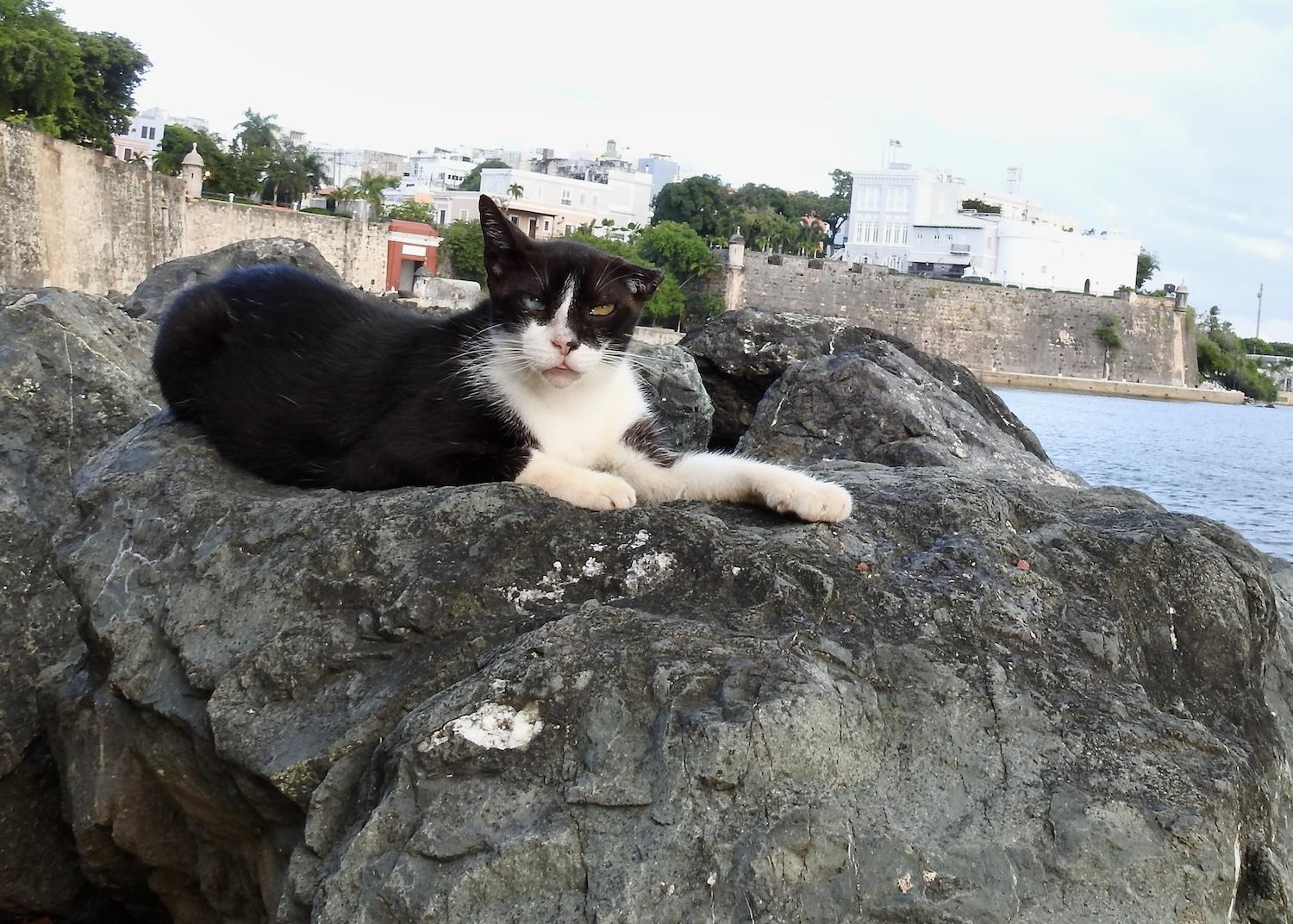
Two-Face is one of the cats that lives along the Paseo del Morro National Recreational Trail in San Juan National Historic Site in Puerto Rico. He's shown in front of the iconic San Juan Gate/Jennifer Bain
When Karla Colom zips down the Paseo del Morro National Historical Trail at sunset in a golf cart loaded with food, water and cleaning supplies, the cats of Old San Juan come out of hiding. Colony by colony, they materialize from nooks in the rocks along the ocean and hiding places in the greenery at the foot of ancient walls built to protect the Puerto Rican city from attack by sea.
“Hey Mick Jagger. Hey Mr. Jagger. Come here sweetheart. He’s very skittish.”
“That’s Gizmo. She wasn’t social. It took me two years to befriend her.”
“Hey Flash, I love you.”
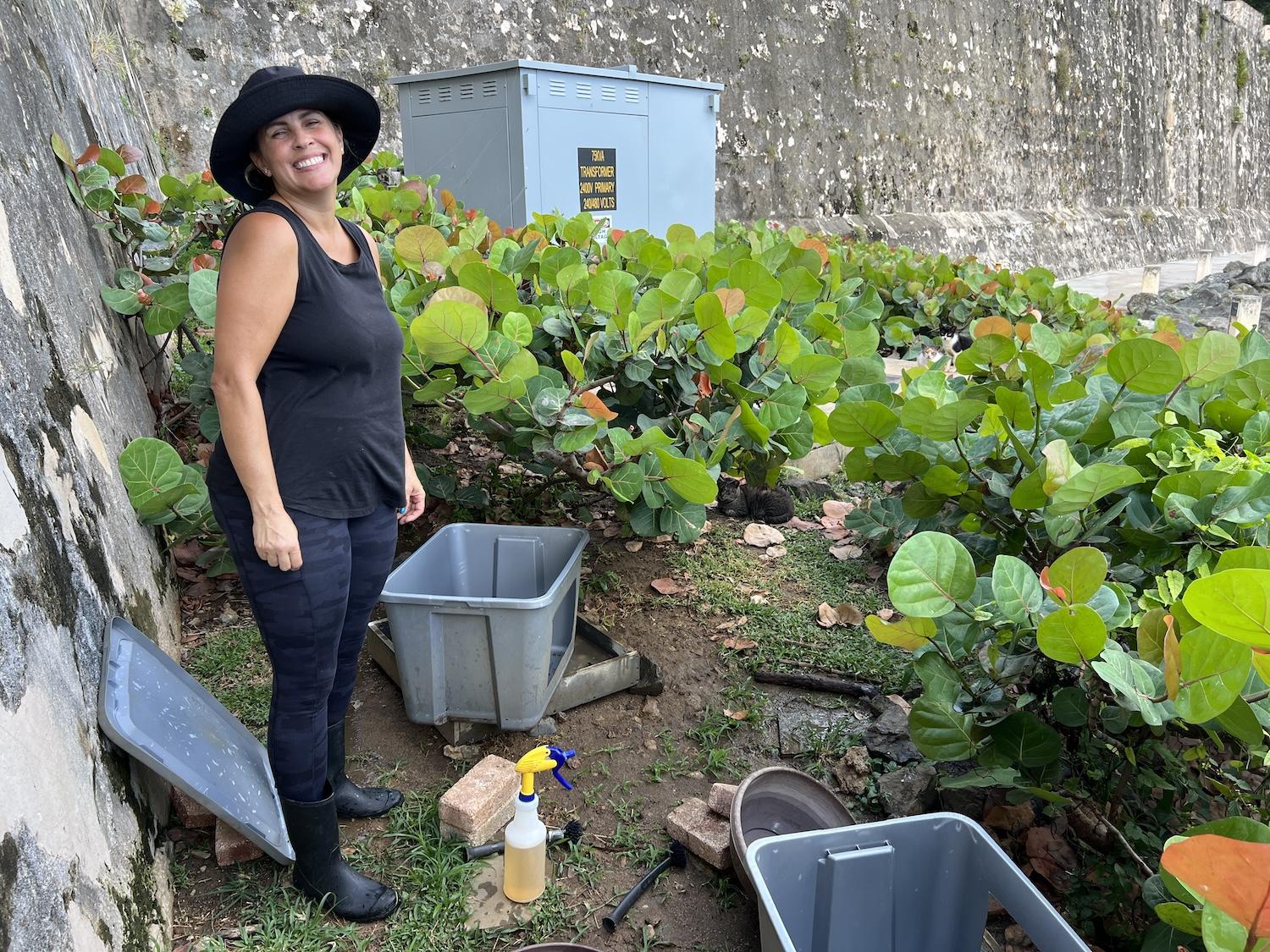
Karla Colom volunteers three times a week with Save A Gato, providing food and water for the cats that live along a paved pathway on National Park Service land in San Juan. The job involves a lot of cleaning/Jennifer Bain
Colom — a volunteer with Save A Gato — knows the names, back stories and personalities of each cat. Talking to her feline friends helps pass the time as she makes the rounds at San Juan National Historic Site in a one-of-a-kind agreement between the National Park Service and a non-profit organization.
It’s a deal that’s under review as the Park Service no longer wants to condone the feeding of animals, especially those that are considered an invasive species. Its draft Free-Ranging Cat Management Plan/Environmental Assessment, released in August with a public meeting, proposes three solutions. Keep the status quo. Remove the cats. Give an animal welfare organization six months to trap and remove the cats — its preferred option — and then remove the feeding stations.
“It makes my stomach turn and blood boil,” Colom says of the situation. “These cats are not free roaming. This is their home.”
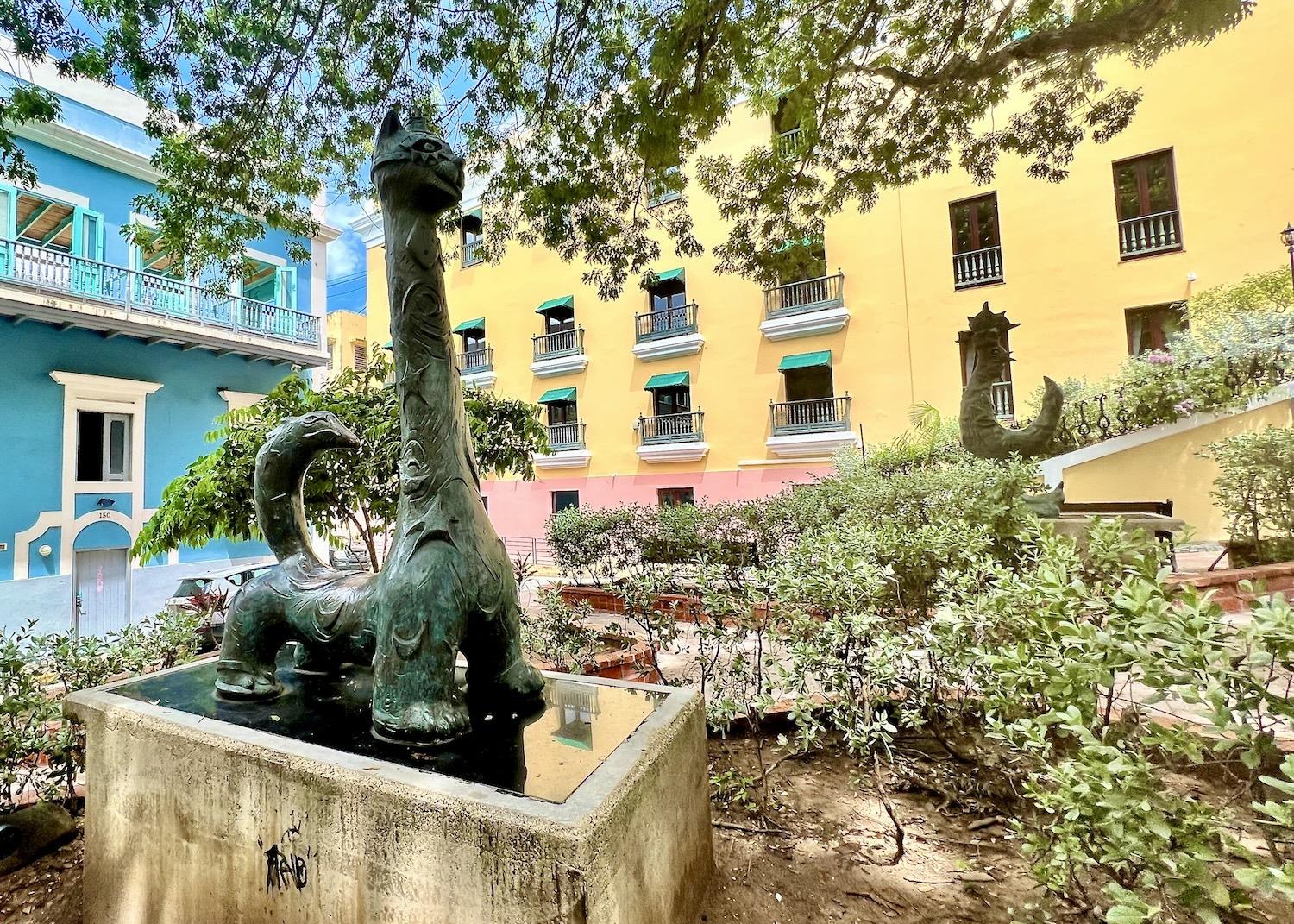
Gato Girafo, a 2000 bronze of a cat-giraffe by Jorge Zeno, stands in a small Old San Juan plaza near the San Juan Gate and Paseo del Morro where somewhere between 100 and 200 cats live/Jennifer Bain
The only NPS unit in Puerto Rico draws more than one million human visitors a year.
Some people don’t like to see or smell the feral cats. But many are eager to photograph the iconic cats that roam the Paseo steps from blue cobblestone streets, the Gato Girafo bronze statue of a fantasy cat-giraffe by artist Jorge Zeno, and the Casa Museo Felisa Rincón de Gautier that celebrates a woman who was mayor from 1946 to 1968 and whose love of street cats continues to influence the neighborhood.
To put this story in proper context, you have to understand the geography of San Juan National Historic Site. The well-preserved complex of Spanish colonial masonry military fortifications includes Old San Juan’s Castillo San Felipe del Morro (El Morro) and Castillo San Cristóbal, as well as Fort San Juan de La Cruz (El Cañuelo) across the bay. It includes the iconic San Juan Gate and most of the historic city wall.
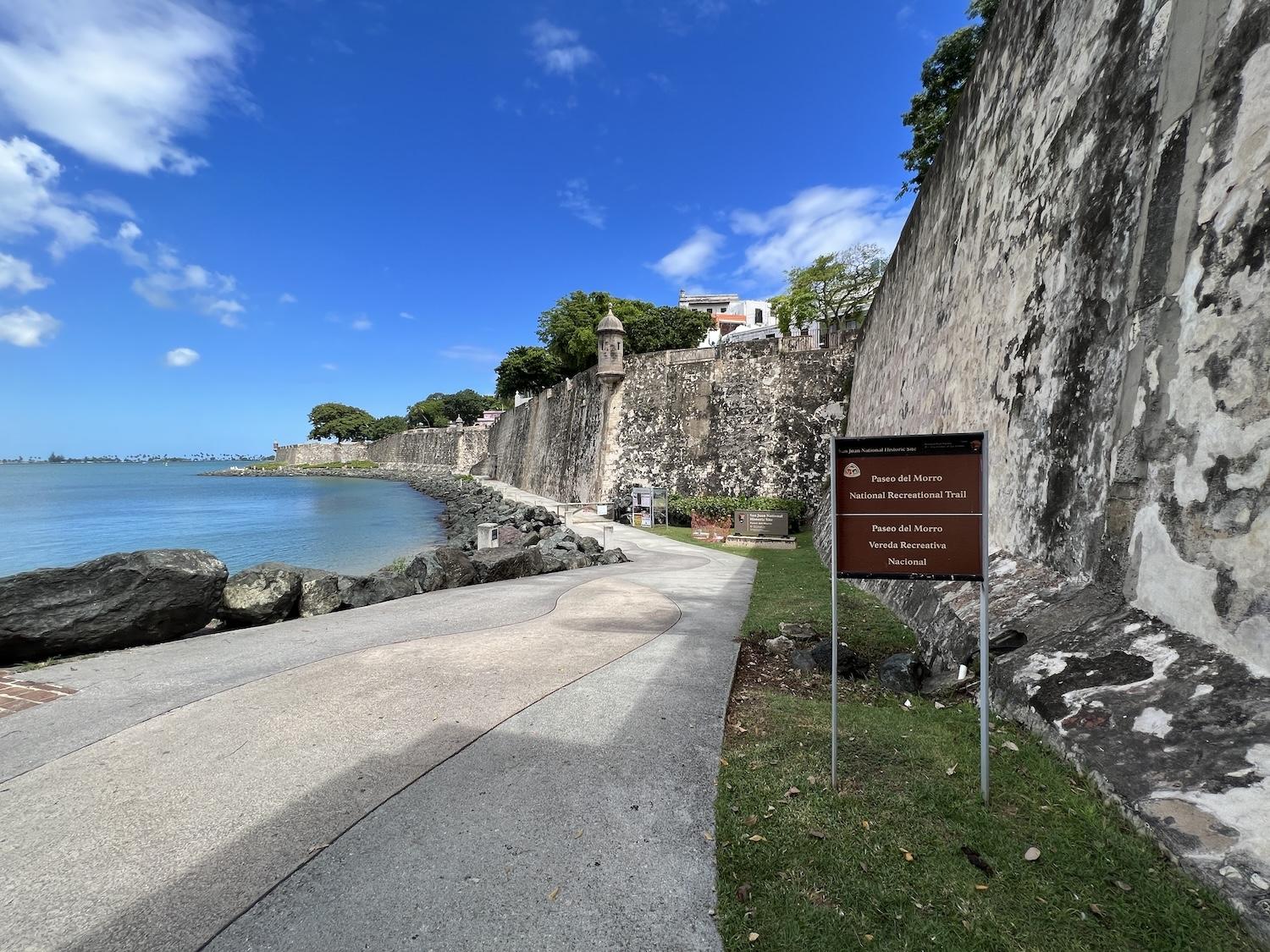
The popular Paseo del Morro paved pathway has been closed for months due to water leaking through the historic walls/Jennifer Bain
Built in 1999 and designated a national recreational trail two years later, the Paseo del Morro hugs the coast in San Juan Bay along the base of the fortification walls between El Morro and the San Juan Gate. Shortly after the paved walking path was constructed from what started centuries ago as an informal path, the park service noticed that about 120 free-ranging domestic cats had colonized the area. Save A Gato says they had long been living there.
In 2005, the park’s superintendent and Save a Gato signed an unusual Memorandum of Understanding allowing the fledgling non-profit to feed, survey, trap and remove free-ranging cats with the goal of eventually removing all cats. Using a TNR (trap-neuter-release) program, friendly adults and kittens who can be socialized get to enter the adoption program in search of forever homes. The others are returned to their colonies and monitored, fed and given fresh water.
By 2022, however, five feeding stations climbed to seven and the cat population seemed to be growing. The Park Service said a 2021 camera trap survey identified at least 200 cats including kittens and pregnant or recently pregnant cats. New cats keep arriving, some abandoned by people who know they will be fed. Save A Gato agrees that people dump their pets in the area but doesn't believe the population is that high.
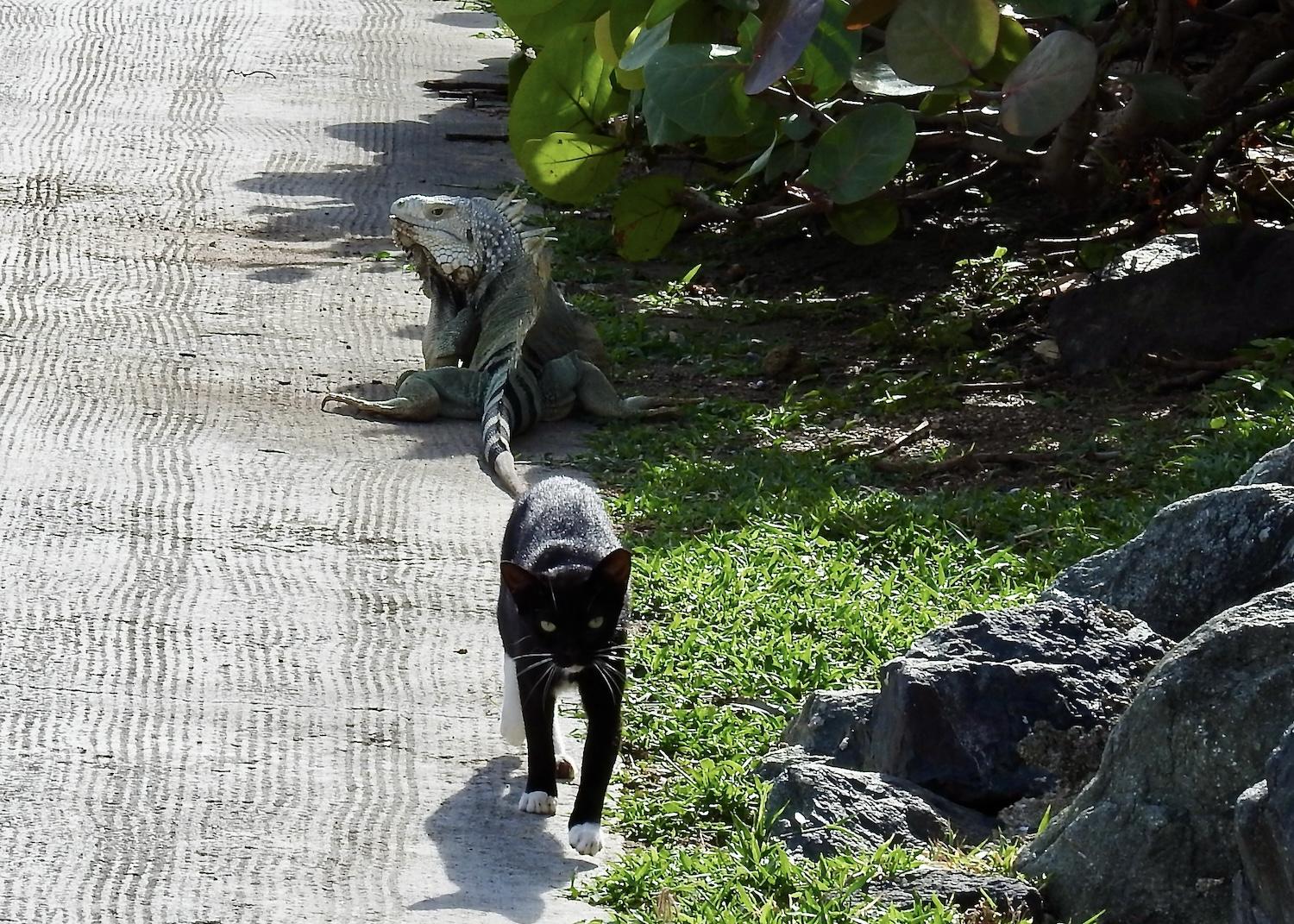
Green iguanas and feral cats are invasive species that co-exist in San Juan National Historic Site/Jennifer Bain
In any event, the NPS began laying the groundwork for a new plan to “improve the safety of its visitors and employees, protect park resources and reduce impacts to native wildlife species associated with free-ranging cats, alleviate nuisance issues, align the visitor experience with the purpose of the park, and bring the park into compliance with existing authorities for invasive species.”
It held two open houses and invited input on two proposed solutions. A “no-action alternative” would let Save A Gato continue to manage the cats while reducing and ultimately eliminating their presence. Feeding stations would be reduced. Cats without tags (ear tips) would be removed. Population surveys would be done quarterly. But the federal agency's preferred alternative would be to contract a professional organization to remove the cats and feeding stations and monitor the results.
People panicked and feared all the cats would be killed. The story captured headlines across North America in November 2022.
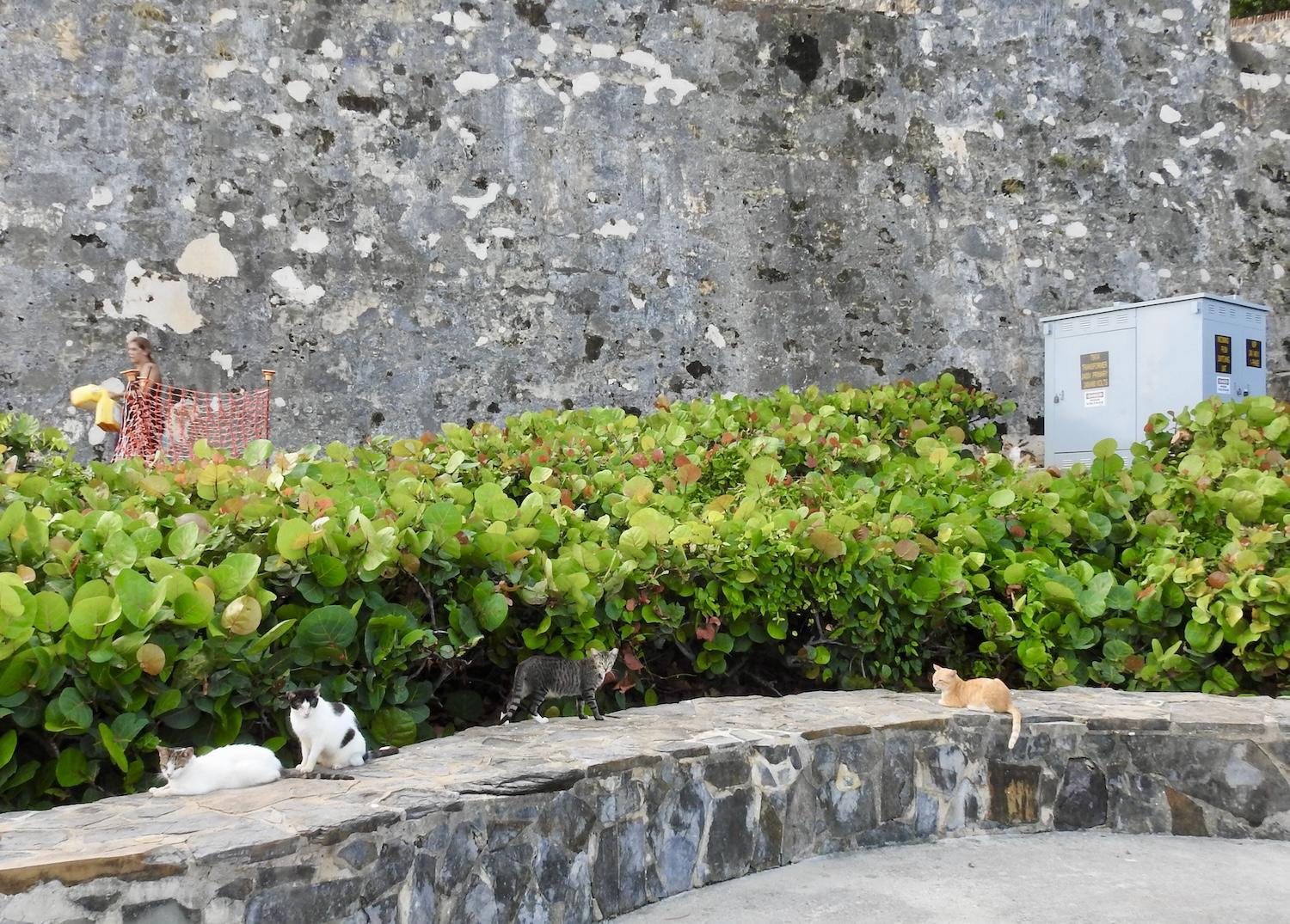
Cats lounge along the Paseo del Morro as Save A Gato volunteer Karla Colom cleans their feeding station and water bowls in the greenery just off the popular pathway/Jennifer Bain
Save A Gato asked its Facebook followers to weigh in and tell the NPS how much having a healthy, sterilized cat population means to people.
“During my visit I was reminded of the cats in Rome which are also considered a tourist attraction, and merchandise featuring them is sold there,” one person observed.
“I also took note of other visitors’ exclamations of joy — adults and children alike — at seeing the cats,” wrote another.
“We all want the problem of overpopulation and abandonment of cats in our country fixed,” a third said, “but animals cannot be the ones paying with their lives for the actions and neglect of humans.”
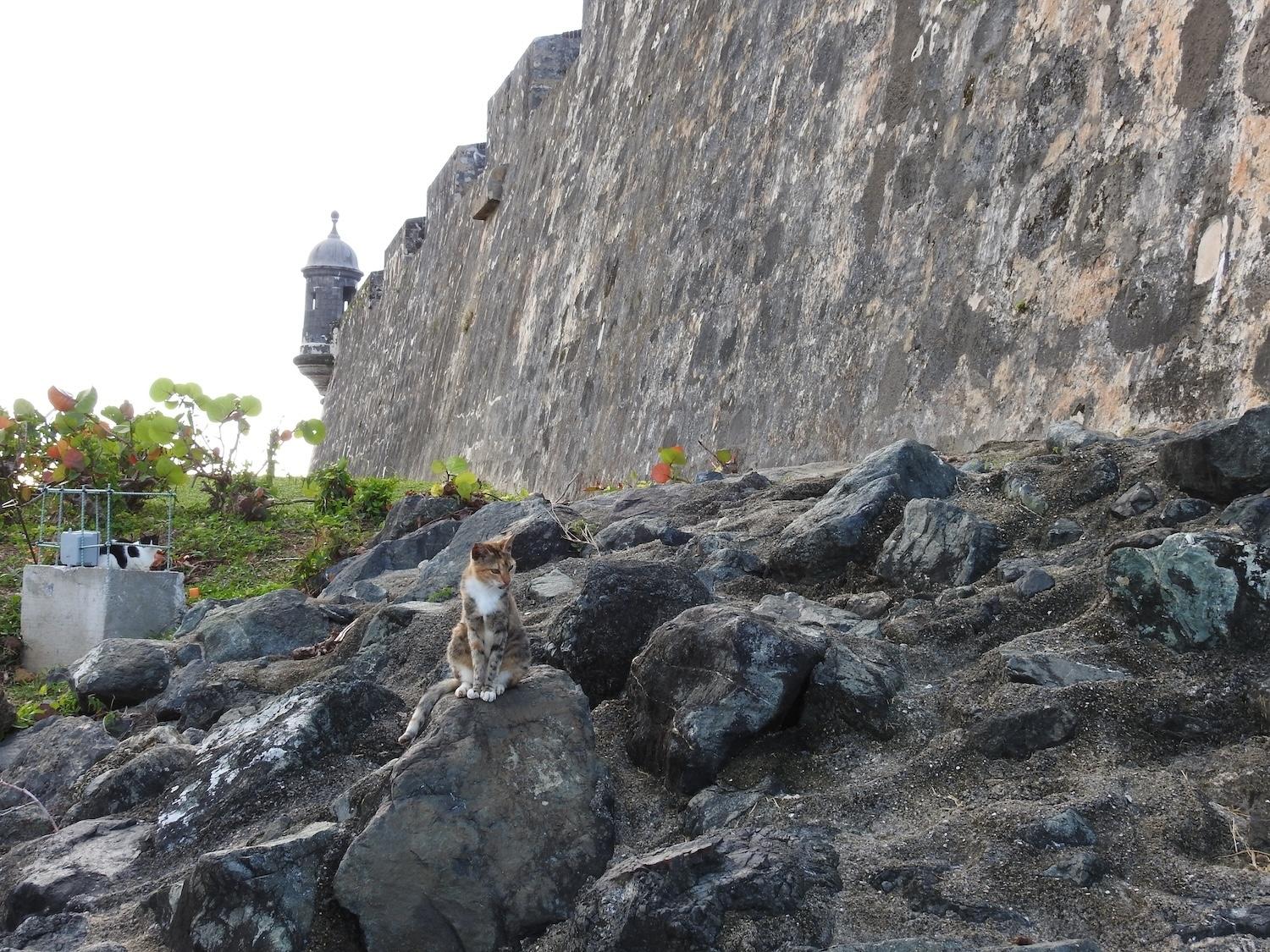
Two cats relax in the rocks along the Paseo del Morro walkway by the historic walls of Castillo San Felipe del Morro (El Morro) in Old San Juan/Jennifer Bain
Then on June 14, the Paseo del Morro was closed because water was leaking through the historic wall. Two months later, the draft management plan was released, now with three alternatives, including the new one that would provide six months leeway to remove the cats.
When I arrive in Puerto Rico in September, the Paseo is still closed. Save A Gato gets corporate food donations and grants for vet bills, but has missed out on months of donations from street cat-friendly tourists. It invites me to tag along on a volunteer shift.
I meet Colom at the group’s home base, a former maintenance shack just off the Paseo that's not on national park land and has been painted pink. There’s a striking cat mural on one wall and plenty of cats milling about. Various yellow "cat crossing" signs warn motorist to slow down. Inside, the space is spotless. Cats that are earmarked for adoption wait in individual cages.
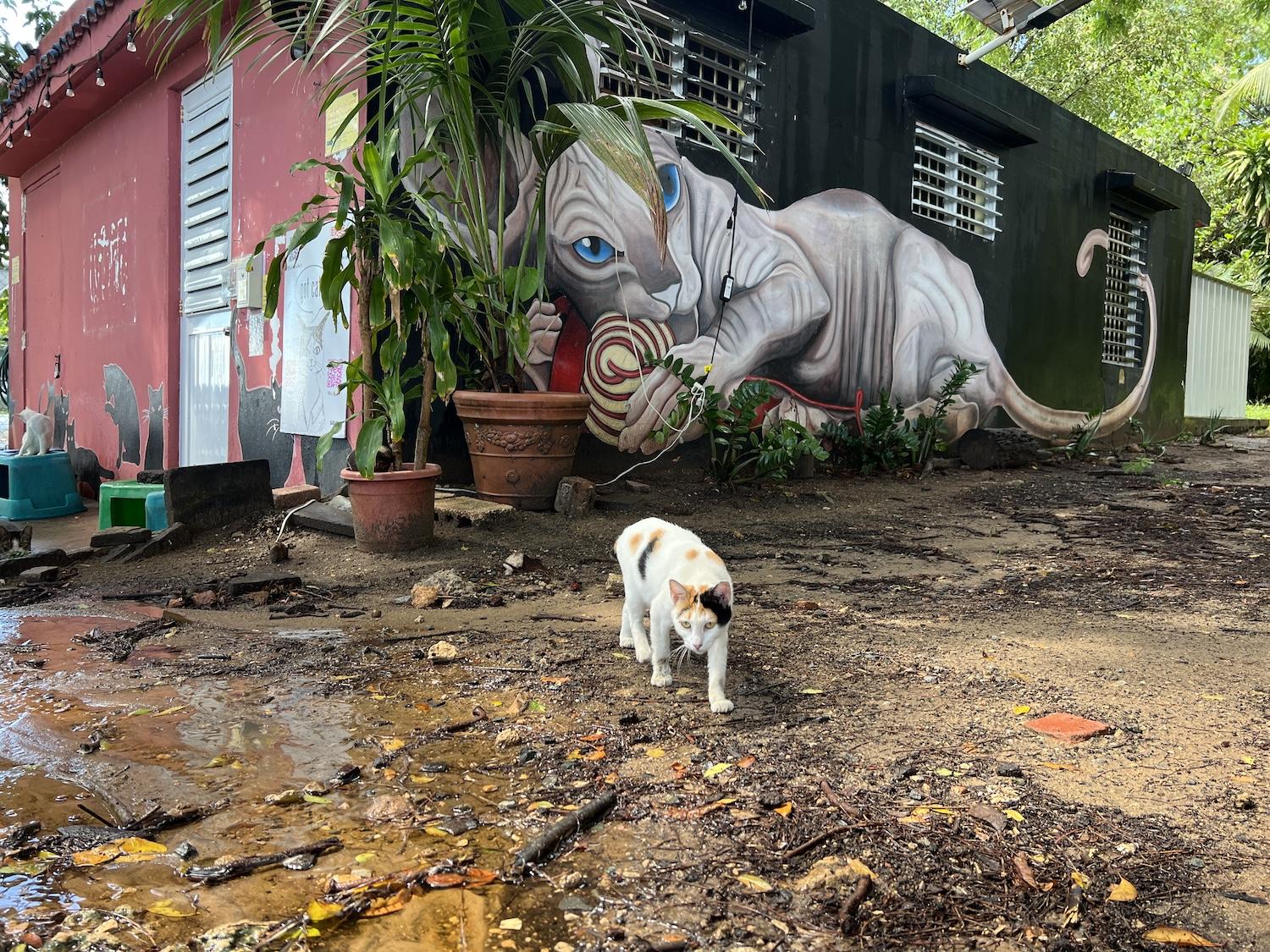
Save A Gato turned a maintenance shack into its headquarters in Old San Juan near the Paseo del Morro and Castillo San Felipe del Morro/Jennifer Bain
“We try to show them that they’re going to be okay,” says Colom, a former teacher who volunteers here three times a week.
Tourists often fall in love with these cats and, if the paperwork isn't qute in order, Save A Gato enlists “flight angels” to deliver the animals to cities in the United States. It also gets the word out through Petfinder.
As we talk, Colom loads supplies into a golf cart. Dry food. Coconut oil and cod liver oil to be mixed in with cans of turkey dinner in gravy. Fresh water. Cleaning supplies. Some tourists, she says with a sigh, mean well but complicate things when they bring their own cat food and treats to the Paseo and cause diarrhea.
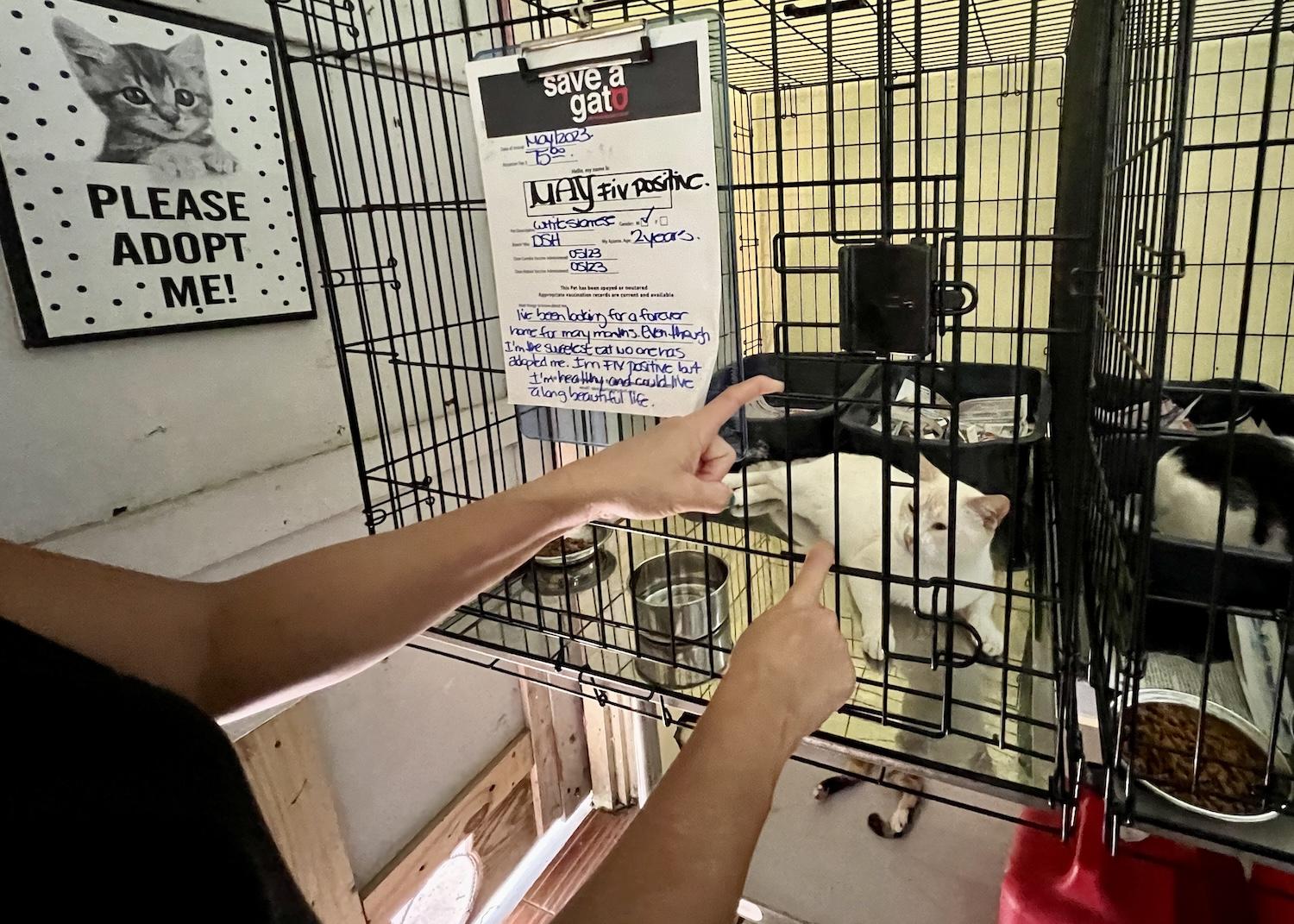
Cats like May wait inside Save A Gato's home base to be adopted/Jennifer Bain
When we arrive at the Paseo around suppertime, Colom unlocks the gate. “Okay so you’re going to see the babies,” she promises. “Here they come. Hey fellas. What’s going on? This is Vladimir. That’s Simba.”
It gets confusing to keep track of everything, but today there seem to be five feeding stations spread out along the Paseo. Each area is home to a different colony of cats.
At each colony, Colom takes stock of the feeding stations, which are tucked discreetly off the pedestrian walkway. Dried cat food is put in a clear plastic tub within a larger, covered plastic tub with a small entrance cut into it. The food is put on bricks and the tub is filled with a bit of water to keep cockroaches and ants at bay. Then Colom finds hidden bowls of water and cleans and replenishes them.
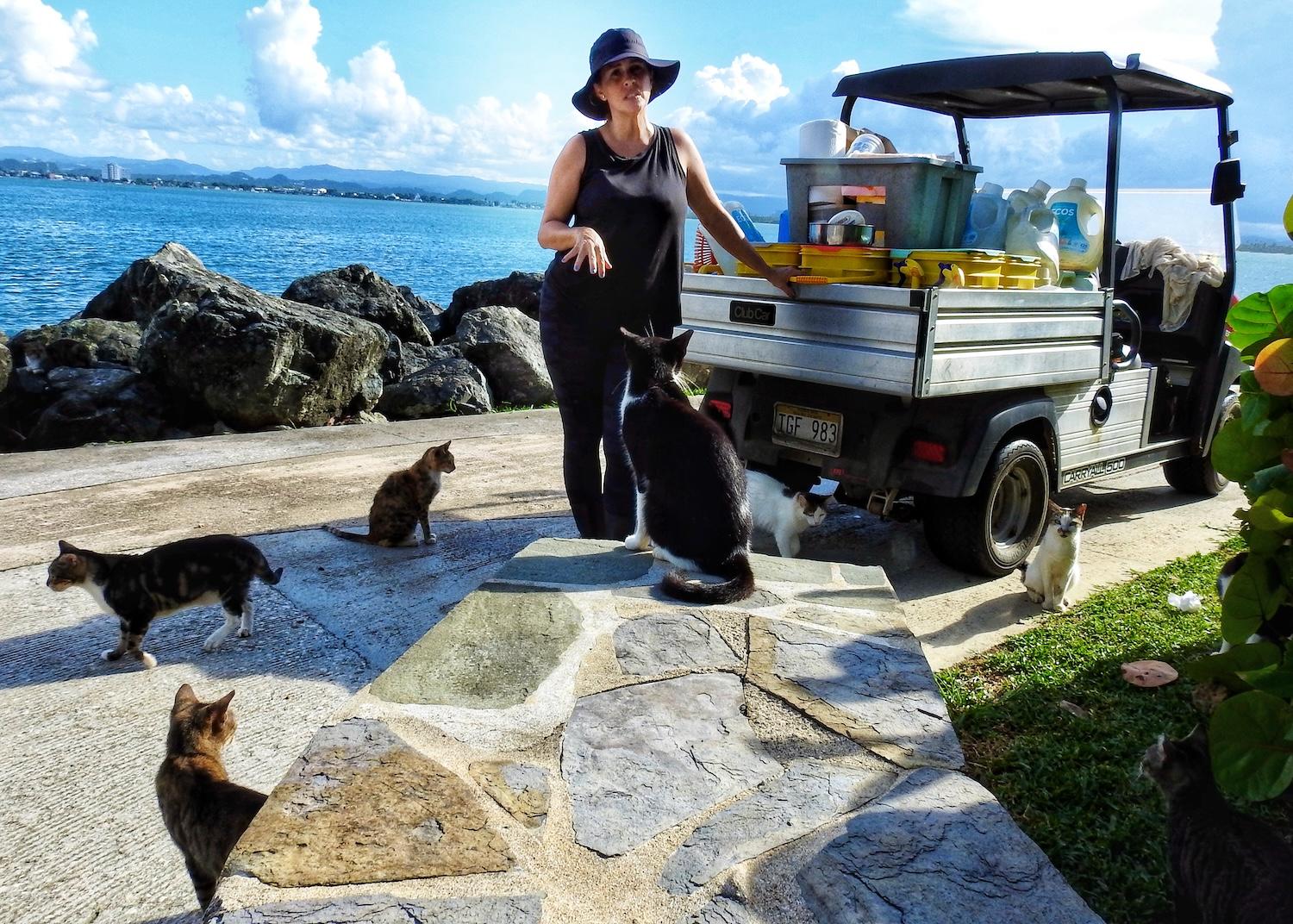
Save A Gato volunteer Karla Colom delivers food and water to the cats that live in colonies along the Paseo del Morro in San Juan National Historic Site/Jennifer Bain
As much as we love cats, they're considered to be one of the world’s worst invasive species. They aren’t subject to leash laws like dogs are. Feral and unattended outdoor domestic cats kill birds, rodents, insects, reptiles and amphibians.
The cats of Old San Juan do get fed but that doesn't mean they have an easy life. NPS surveillance cameras caught invasive green iguanas and rats eating from their feeding stations.
There’s also at least one area behind the bushes that serves as an oversized litter box and has to be cleaned. The plastic feeding station tubs have to be sprayed and scrubbed. It’s tough to find volunteers for such drudgery, but Colom says “the ones that stay, it’s because we enjoy it. We enjoy the cleaning, talking to the cats, seeing the ships come in. The cats are our friends.”
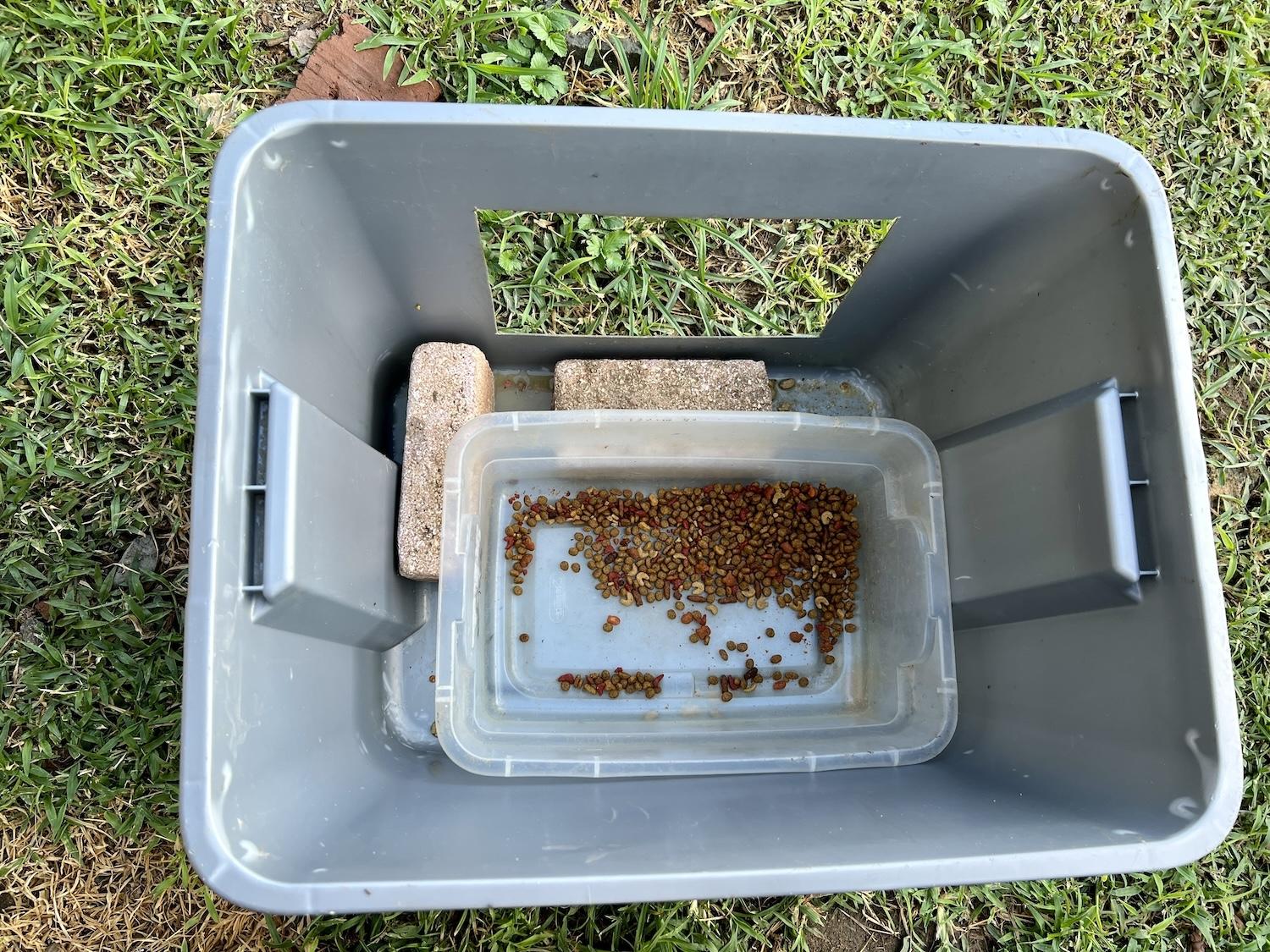
Cat food is put in a tub inside another tub and surrounded by water to keep the cockroaches and ants at bay/Jennifer Bain
It typically takes Colom one hour to prep and two hours to do the feeding and cleaning — while listening to music and watching the sunset — but today is slower because we're talking. On Saturdays, she does a deep clean.
We drive over the water leak and I wonder why it can't just be fenced it so people can at least stroll most of the Paseo. The closure has affected Save A Gato monetarily, but Colom admits “the cats are happier because nobody bothers them.”
Grumpelina. Taco. Nina. Kevin. Archie. John the Lover. Leo. Midnight. Clyde. Blinky. Brad Pitt, who usually “gives you the best photographs." She introduces me to everyone, but today it's a black-and-white boy with one blue eye, one green eye and a crooked ear that lingers for photos. His name is Two-Face in honor of the supervillian Harvey Dent character who is Batman’s adversary.
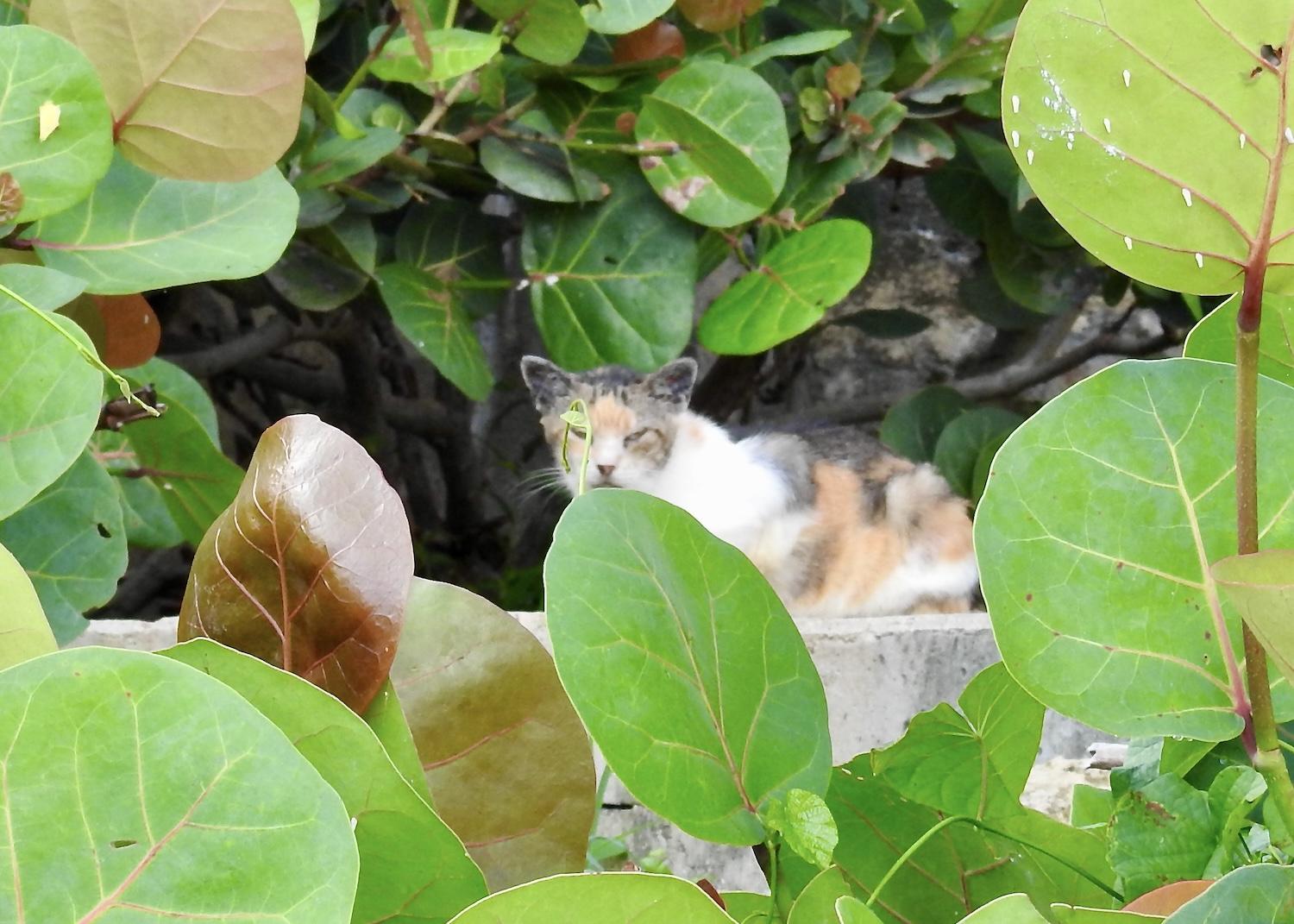
The cats of Old San Juan and the Paseo del Morro come in all shapes, sizes and temperaments. They're usually featured on an annual fundraising calendar for Save A Gato/Jennifer Bain
“People come from all over the planet just looking for the cats,” Colom says with pride. “They tell us this is the highlight of their trip.”
Save-A-Gato Sanctuary is even on TripAdvisor. Reviews, predictably, range from "disgusting cats infesting a national historic site” to "heaven on earth for cat lovers." One person said “I actually packed 4 bags of cat treats and my family thought I was crazy but we had the most fun day feeding all the cats.”
When the Park Service collected public comments from Oct. 20 to Dec. 10, 2022, it drew 2,511 responses in Spanish and English, from locals and tourists. The public scoping document runs 519 pages. While those who weighed in were overwhelmingly in favor of leaving the cats alone, some people made points like "relocation is hard, yes, but hardly impossible for a cat." One person pointed out that "there are opportunities for the cat colony to be featured prominently as part of Old San Juan's tourist attraction. It is an unusual and quirky element that brings some life into the heavily urbanized historic center."
Of all the things I do during my week in Puerto Rico — including milking a goat at a sustainable farm called Frutos del Guacabo — it's my time with the street cats that I keep thinking about.
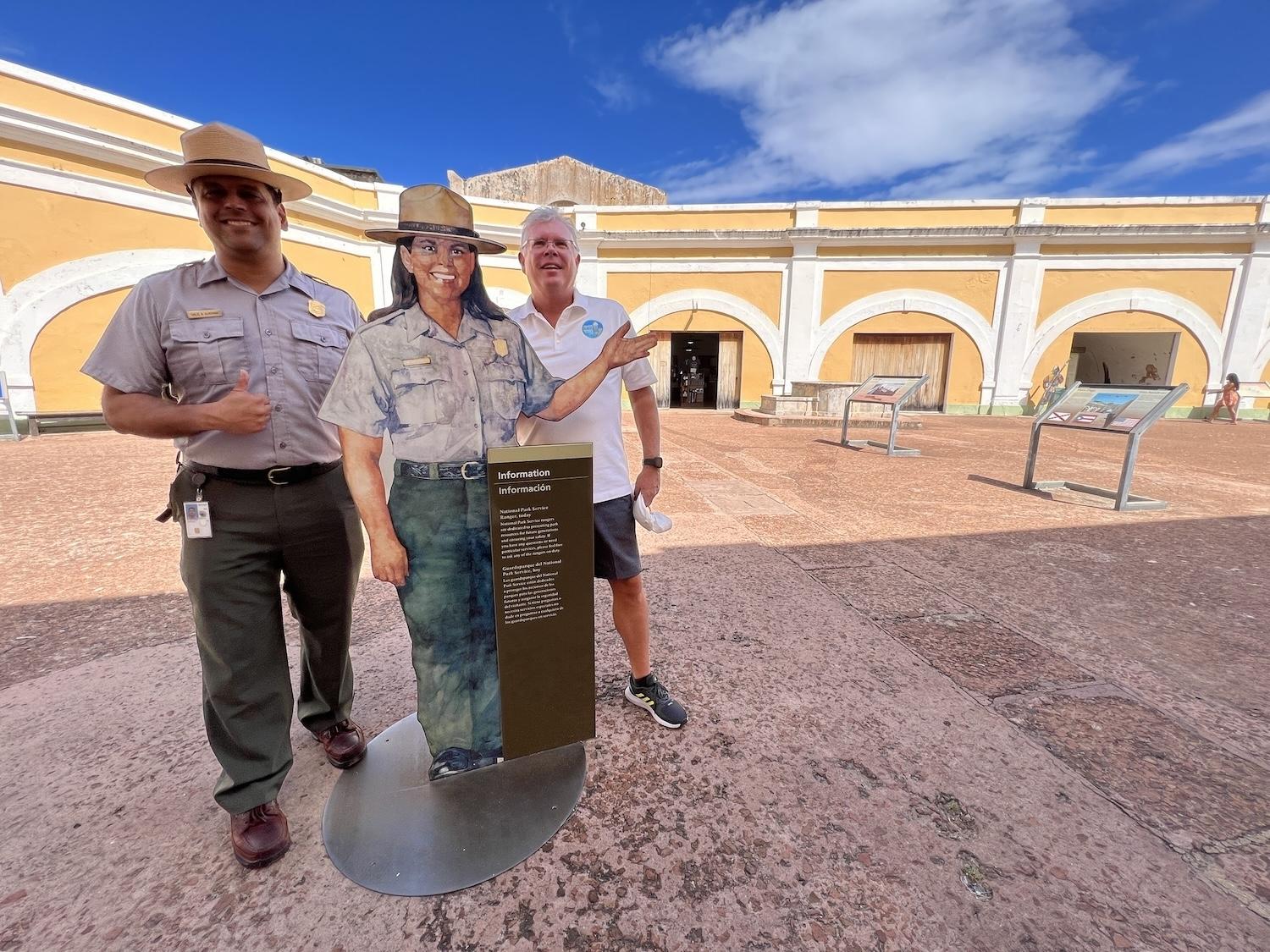
At San Juan National Historic Site's El Morro, ranger Carlos Almodóvar is the head of interpretation. Mike Gillespie, right, founded the Friends of San Juan National Historic Site/Jennifer Bain
Carlos Almodóvar, division manager for interpretation for the San Juan National Historic Site, takes me on a private tour of El Morro and brings the fortification to life. Mike Gillespie, founder of the Friends of San Juan National Historic Site, shares all the great work his team does, particularly on the education front, and escorts me from El Morro to the San Juan Gate and down another public walkway called Paseo de la Princesca. I visit Castillo San Cristóbal on my own to see the historical "graffiti" of ships on a tunnel wall that Almodóvar has mentioned.
But in my final free moments in the city, I find myself returning to the locked Paseo del Morro gate and looking in vain for one last glimpse of Two-Face. I think about something Colom told me about these tough cats: "Just because they don’t live in a home, and just because you can’t touch them, doesn’t mean they aren’t loved. They matter to a lot of people.”
Two months later, as I finally write this story, I check in for new developments. Save A Gato doesn't have the volunteer resources to put together its annual fundraising calendar for 2024. The Paseo remains closed, awaiting repairs. The National Park Service finished collecting public input on its draft free-ranging cat management plan in October. There is no word on its next move.
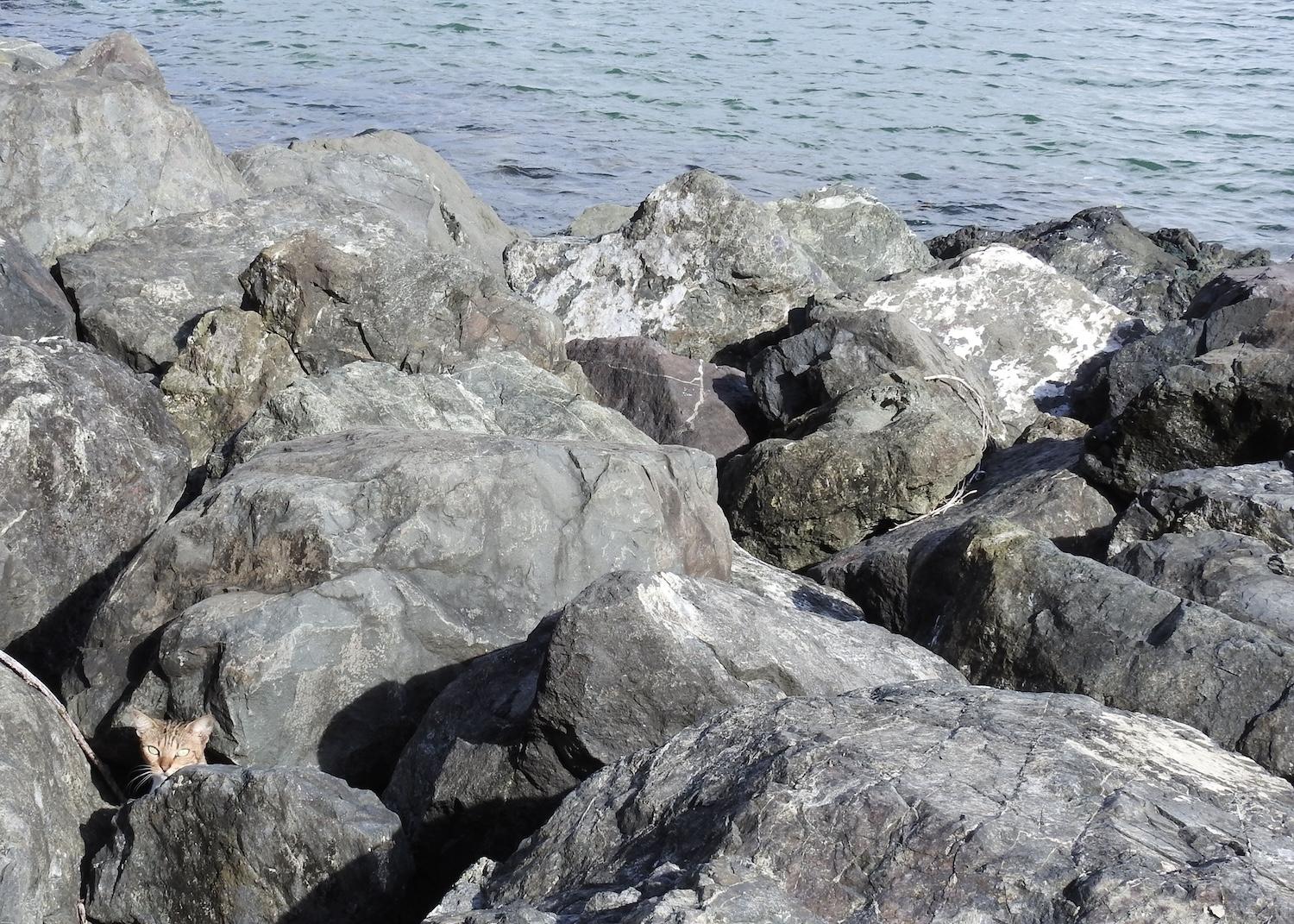
Cats live and lounge among the rocks along the Paseo del Morro in San Juan/Jennifer Bain



Comments
Thank you for a beautiful story about the human-animal connection manifest in the cats of El Paseo. "They matter to a lot of people." I truly hope for a management plan that is humane to both cats and the people who care about them. The cats are a naitonal treasure.
There has to be multiple solutions. Adoptions, fosters, tnr all three are good. Take care of them and and find places for some. Thin the population out. TNR is great. There was a cat that hung out with mine. When Humane Society was helping me get my 2 cats moved with me the stray got humanely trapped. They were going to do TNR but after the neuter he got so sweet they put him up for adoption. And named him Lane after me, lol. Have visitors who love cats volunteer when there, many come to see the cats, right? Why wouldn't they want to help? Visitors might find one or two that they want to adopt. Of course you have to check them out and that might be difficult but it can be done. I am a wheelchair but I've been thinking about moving and Puerto Rico and cats sound awesome. I could help with something. Build a dormitory for visitors who want to stay awhile and help. I could help with researching the potential adopters and other office work as long as I have a cat in office. Someone could contact people around the world for help. I bet if there was a little gift shop for humans and cats would make money. .Just scale down the number of them and TNR will take care of most of the spraying. Train them to do their business further away. There are many solutions if you try UPS. TRY HARDER! Thank You.
Great ideas Suzanne! I am down in Puerto Rico this month and am trying to help out.
Hi Jennifer! I am down in Old San Juan until the end of March and worked with Karla on Thursday. The Paseo is opened again and I met many of the same cats that you did. They were able to complete the 2024 calendar and it is available on saveagato.com for a $20 donation. They are still working to convince the NPS to allow them to continue. I'm sure when you were working with Karla you saw how many people asked about the work Karla was doing and really very positive about the cats. I hope they are able to continue!!
Nancy - so glad you are down there and helping out. When I was out with Karla, the paseo was closed so we didn't actually see anyone else. But thanks for letting me know about the calendar -- I ordered one.
There have been various studies which support that trap, neuter, return (TNR) does indeed reduce the numbers of community cats (Levy, et.al.). The issue is the Save A gato is operation on incredibly limited funds and they just don't have the capacity and volunteer base to conduct an effective TNR program to reduce and/or manage the population of community cats. I think they need a good communications strategy that incldues volunteer recruitment, a robust donation campaign which inlcudes not only thier supporters on social media, but local busineesses and cruise lines. I'm in Gainesville, FL and we have a great TNR program (Operation Catnip), and the program works becasue they have a great donor and supporer base, including grants, and not to mention the support of the University of Florida's College of Veterinary Medicine's Maddie's Shelter Medicine program.
One of the highlights of us visiting Puerto Rico has always been stopping to see the Gatos. We're here now in 2024 and unfortunately they are gone. Very sad for the cats As well as I'm sure the many Visitors who look forward to that as a highlight of their visit.